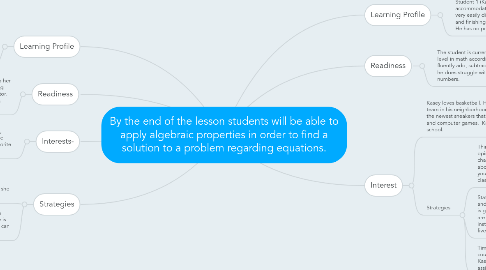
1. Learning Profile
1.1. Student 2 Ashley- Ashley has been diagnosed as LD. Her accommodations are small group instruction, calculators, and seating close to the board. Ashley tries very hard in class, but seems to have some trouble retaining information.
2. Readiness
2.1. Ashley is currently in 7th grade, but tested on a 3rd grade level according to her assessment. Ashley basic addition calculations, but struggles with subtracting multi-digit numbers, multiplication facts, and long division without a calculator. However, Ashley can perform all of these operations with the assistance of a calculator. She also has trouble with calculating rational numbers.
3. Interests-
3.1. Ashley loves social media. She enjoys talking on her phone, hanging out with her friends, and shopping. Ashley is on the school track team, and is great at drawing. She says her favorite subject is art, and she likes coming to school.
4. Strategies
4.1. Variety would be one strategy that I would use with Ashley. Instead of just assigning her a task, I would want to give her multiple options and have choose which tasks she feels that she might perform best on.
4.2. Small group instruction would allow me to work closely with Ashley to address her misconceptions quickly. This strategy is also apart of her I.E.P. With her working in a smaller group I can have more time to work with her on what she needs.
5. Learning Profile
5.1. Student 1 (Kasey) Kasey was diagnosed with ADHD and has an I.E.P. Kasey's accommodations are small group, extended time, calculator, and breaks. He is very easily distracted, struggles with focusing on tasks for long periods of time, and finishing his work. He has also had issues with blurting out answers in class. He has no problem with retention.
6. Readiness
6.1. The student is currently in 7th grade, but performing on a 5th grade level in math according mid year assessment. The student is able to fluently add, subtract, multiply, and divide whole numbers. However, he does struggle with performing these operations with rational numbers.
7. Interest
7.1. Kasey loves basketball. He plays for the school and a recreation team in his neighborhood. He also enjoys football, and talking about the newest sneakers that are coming out. He loves video games, and computer games. Kasey says math is his favorite subject in school.
7.2. Strategies
7.2.1. Think-Pair-Share- I would use this strategy because it gives Kasey a chance to voice his opinions without speaking out of turn or blurting his answer out. He knows that he will get a chance to speak so he waits for his turn. In this strategy I give a question or topic then you think about what you want to say or how you want to answer, then you pair up with the person next to you and discuss your answer and what you think, finally you all share your ideas out to the class.
7.2.2. Station Rotations- I use this strategy with Kasey so that he won't work on one task for to long and loose focus. There are three stations and he spends 20 minutes at each one. One station is group work, another is direct teaching, and the last is individual station where the students are on a computer program that his adaptive to their level. He also receives small group instruction when he his in station rotations because the class is broken up into 3 groups of five.
7.2.3. Timer- having a timer displayed on the promethean counting down each activity we do in class would help Kasey know exactly how much time he has left to finish an assignment.
